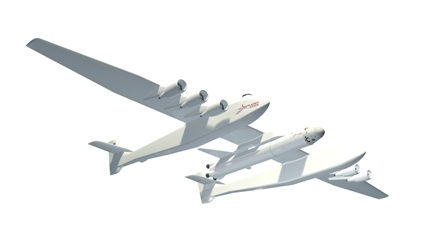Microsoft co-founder Paul Allen, Scaled Composites founder Burt Rutan and ex-NASA administrator Michael Griffin today unveiled a privately-funded programme to develop an orbital spaccraft that could launch up to 6,200kg (13,500lb) of cargo or six passengers into low-earth orbit.
The Stratolaunch system would include a massive carrier aircraft, a SpaceX-built rocket engine and what appears to be an all-new capsule. It should be ready for flight testing in 2016.
“I would just say that this is not a preliminary design at this point,” said Burt Rutan, chief designer of the Allen-funded SpaceShipOne. “There are detailed analyses, detailed structural designs. This is not a sketch, this exists in hundreds of detailed drawings. And it’s relatively close to [being built] as soon as we can get a building big enough.”
The orbital vehicle will be lifted to altitude by a massive successor to the Scaled Composites WhiteKnightTwo mothership.
“If you’re going to orbit, the performance advantage of air-launch [compared to ground-launch] is only about 5 or 10%,” Rutan said. “So 5 to 10%, does that justify building an airplane to do it?...It’s a small advantage to air-launch, but it’s in an industry where a small advantage is actually big.”
The Stratolaunch concept calls for a twin-fuselage carrier aircraft described as the largest aircraft ever constructed. The aircraft will be powered by six engines, with a wingspan of 115m (380ft) and a maximum gross takeoff weight of more than 500,000kg (1.2 million lbs), comparable in size and weight to an Airbus A380.
 |
|---|
©Stratolaunch |
The aircraft, to be built and tested in Mojave, California, will require 3,600m (12,000ft) runways to operate. No specific launch airport has been decided, but NASA’s Kennedy Spaceflight Center was mentioned in the press release.
Once at altitude, the spacecraft will be launched into orbit by a single SpaceX Merlin multistage booster, propelled by RP-1 kerosene and liquid oxygen oxidizer. The booster will be shorter than the existing Merlin models, nine of which currently power SpaceX’s Falcon 9.
The launch vehicle will be capable of putting 6,200kg (13,500lb) of cargo, and eventually humans, into low earth orbit (LEO). The payload capacity puts Stratolauncher in roughly the same category as the Boeing Delta-II, no longer produced, and the new Orbital Sciences Antares (formerly Taurus II). The service is initially aimed mainly at small and medium communications satellite manufacturers.
Requests for detailed specifications were declined, citing competitive concerns.
Discussions on the project began in October, 2004, immediately following the final flight of SpaceShipOne. One hundred people are already assigned to the project. Flight testing of the carrier aircraft is planned for 2015, with a first launch in 2016.
Air-launching rockets allows for significantly greater flexibility than ground-launching. The rocket can be delivered to the nearest suitable airport and launched anywhere within the aircraft’s operational radius.
Paul Allen is best known in the space world for financing SpaceShipOne, the Scaled Composites spacecraft that became the first private vehicle to cross the Karman Line into space. A follow-on, SpaceShipTwo, was developed without Allen’s involvement for use by suborbital tourism company Virgin Galactic.
Source: Flight International


























